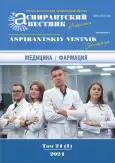Сравнительный анализ потребления противоэпилептических лекарственных препаратов, отпускаемых бесплатно или со скидкой
- Авторы: Устинова Л.П.1, Филина И.А.1,2
-
Учреждения:
- ФГАОУ ВО «Белгородский государственный национальный исследовательский университет»
- ФГБОУ ВО «Орловский государственный университет имени И.С. Тургенева»
- Выпуск: Том 24, № 1 (2024)
- Страницы: 52-58
- Раздел: ОРГАНИЗАЦИЯ ФАРМАЦЕВТИЧЕСКОГО ДЕЛА
- URL: https://ogarev-online.ru/2410-3764/article/view/263404
- DOI: https://doi.org/10.35693/AVP321285
- ID: 263404
Цитировать
Полный текст
Аннотация
Цель – провести сравнительный анализ структуры потребления противоэпилептических лекарственных препаратов, отпускаемых бесплатно или со скидкой, за период 2017–2021 гг. на уровне региона.
Материал и методы. Информационную базу составили труды отечественных и зарубежных ученых в области льготного лекарственного обеспечения, а также нормативно-правовая и организационная документация по фармацевтической деятельности. Были проанализированы льготные рецепты, выписанные за период 2017–2021 гг. в Орловской области. Для оценки потребления была использована методология УСД/АТХ.
Результаты. Выявлено, что льготные противоэпилептические лекарственные препараты в основном принимают лица в возрасте 40–64 лет. В 2017–2018 гг. противоэпилептические лекарственные препараты больше потребляли женщины, в 2019–2021 гг. – мужчины. Большую часть потребителей противоэпилептических лекарственных средств составляют федеральные льготники, в основном являющиеся инвалидами II группы. Самое высокое значение потребления среди топ-5 МНН противоэпилептических лекарственных препаратов за исследуемый период наблюдается для фенобарбитала. Для препаратов вальпроевой кислоты, топирамата и карбамазепина характерна динамика увеличения потребления на протяжении всего исследуемого периода. Для бензобарбитала выявлена картина стабильности потребления.
Выводы. Анализ структуры потребления противоэпилептических лекарственных препаратов в рамках программы льготного лекарственного обеспечения населения с применением методологии УСД/АТХ позволяет выявить объективные данные о динамике потребления противоэпилептических лекарственных препаратов различных поколений. Чтобы сократить потребление препаратов с неблагоприятным профилем безопасности, необходимо проводить обучающие семинары для врачей соответствующего профиля.
Полный текст
Открыть статью на сайте журналаОб авторах
Людмила П. Устинова
ФГАОУ ВО «Белгородский государственный национальный исследовательский университет»
Автор, ответственный за переписку.
Email: luda.ust-19@yandex.ru
ORCID iD: 0000-0001-8966-0766
аспирант кафедры управления и экономики фармации института фармации, химии и биологии
Россия, БелгородИрина А. Филина
ФГАОУ ВО «Белгородский государственный национальный исследовательский университет»; ФГБОУ ВО «Орловский государственный университет имени И.С. Тургенева»
Email: iafilina@yandex.ru
ORCID iD: 0000-0002-4227-5059
д-р фарм. наук, доцент, профессор кафедры фармакологии, клинической фармакологии и фармации; профессор кафедры управления и экономики фармации института фармации, химии и биологии
Россия, Белгород; ОрелСписок литературы
- Epilepsy: a public health imperative. WHO. World Health Organization. 2019:171.
- Avakyan GN. Issues of modern epileptology. Epilepsy and paroxysmal conditions. 2015;4:16-21. (In Russ.). [Авакян Г.Н. Вопросы современной эпилептологии. Эпилепсия и пароксизмальные состояния. 2015;4:16-21]. https://doi.org/10.17749/2077-8333.2015.7.4.016-021
- Gromov SA, Sivakova NA. Modern aspects of resolution of epilepsy. Epilepsy and paroxysmal conditions. 2019;11(1):21-26. (In Russ.). [Громов С.А., Сивакова Н.А. Современные аспекты разрешения эпилепсии. Эпилепсия и пароксизмальные состояния. 2019;11(1):21-26]. https://doi.org/10.17749/2077-8333.2019.11.1.21-26
- Coppola G, Piccorossi А, Operto FF, Verrotti A. Anticonvulsant drugs for generalized tonic-clonic epilepsy. Expert Opin Pharmacother. 2017;18 (9):925-936. https://doi.org/10.1080/14656566.2017.1328499
- Brodie MJ. Pharmacological Treatment of Drug-Resistant Epilepsy in Adults: a Practical Guide. Curr Neurol Neurosci Rep. 2016;16(9):82. https://doi.org/10.1007/s11910-016-0678-x
- Chowdhury A, Martin J Brodie. Pharmacological outcomes in juvenile myoclonic epilepsy: support for sodium valproate. Epilepsy Res. 2016;119 (1):62-65. https://doi.org/10.1016/j.eplepsyres.2015.11.012
- Johannesen K, Marini C, Pfeffer S, et al. Phenotypic spectrum of GABRA1: from generalized epilepsies to severe epileptic encephalopathies. Neurol. 2016;87(11):1140-1151. https://doi.org/10.1212/WNL.0000000000003087
- Yacubian EM. Juvenile myoclonic epilepsy: challenges on its 60th anniversary. Seizure. 2017;44:48-52. https://doi.org/10.1016/j.seizure.2016.09.005
- Lagae L, Villanueva V, Meador KJ, et al. Adjunctive perampanel in adolescents with inadequately controlled partial-onset seizures: A randomized study evaluating behavior, efficacy, and safety. Epilepsia. 2016;57(7):1120-1129. https://doi.org/10.1111/epi.13417
- Putilo NV, Volkova NS, Tsomartova FV, et al. The right of citizens to drug provision. M., 2017. (In Russ.). [Путило Н.В., Волкова Н.С., Цомартова Ф.В., и др. Право граждан на лекарственное обеспечение. М., 2017].
- Gertsen AP, Rumyantsev VV, Iskanderova AA, Bakitova AA. Provision of patients with epilepsy with free drugs. Russian Journal of Child Neurology. 2019;14(4):43-56. (In Russ.). [Герцен А.П., Румянцев В.В., Искандерова А.А., Бакитова А.А. Обеспечение пациентов с эпилепсией бесплатными лекарственными препаратами. Русский журнал детской неврологии. 2019;14(4):43-56]. https://doi.org/10.17650 / 2073-8803-2019-14-4-43-56
- Feoktistova YuV, Poddubny EA, Maneeva ES, Eliseeva EV. Normative-legal and organizational bases of preferential drug provision for certain categories of citizens. Tauride Medical and Biological Bulletin. 2018;21(4):120-127. (In Russ.). [Феоктистова Ю.В., Поддубный Е.А., Манеева Е.С., Елисеева Е.В. Нормативно-правовые и организационные основы льготного лекарственного обеспечения отдельных категорий граждан. Таврический медико-биологический вестник. 2018;21(4):120-127].
- Komarov IA, Aleksandrova OYu, Nagibin OA. Modern organization of drug provision of preferential categories of citizens. Federal and regional features. Health manager. 2019;5:53-60. (In Russ.). [Комаров И.А., Александрова О.Ю., Нагибин О.А. Современная организация лекарственного обеспечения льготных категорий граждан. Федеральные и региональные особенности. Менеджер здравоохранения. 2019;5:53-60].
- Sura MV. Drug provision of the population on an outpatient basis at the expense of regional budgets within the framework of the implementation of territorial programs of state guarantees of free provision of medical care to citizens. Medical technologies. Evaluation and choice. 2017;3(29):41-52. (In Russ.). [Сура М.В. Лекарственное обеспечение населения в амбулаторных условиях за счет средств региональных бюджетов в рамках реализации территориальных программ государственных гарантий бесплатного оказания гражданам медицинской помощи. Медицинские технологии. Оценка и выбор. 2017;3(29):41-52].
- Malek N, Heath CA, Greene J. Review of medication adherence in people with epilepsy. Acta Neurol Scand. 2017;135:507-515. https://doi.org/10.1111/ane.12703
- Sura MV. Restrictive drug lists. Legal regulation, functions performed, sources of funding, rules of formation. PHARMACOECONOMICS. Modern Pharmacoeconomics and Pharmacoepidemiology. 2017;1(10):46-56. (In Russ.). [Сура М.В. Ограничительные перечни лекарственных препаратов. Нормативно-правовое регулирование, выполняемые функции, источники финансирования, правила формирования. ФАРМАКОЭКОНОМИКА. Современная Фармакоэкономика и Фармакоэпидемиология. 2017;1(10):46-56]. https://doi.org/10.17749/2070-4909.2017.10.1.046-056
- Bochanova EN, Schneider NA, Zyryanov SK, et al. Evaluation of the consumption of antiepileptic drugs in outpatient practice. Clinical pharmacology and therapy. 2016;25(3):90-92. (In Russ.). [Бочанова Е.Н., Шнайдер Н.А., Зырянов С.К., и др. Оценка потребления противоэпилептических препаратов в амбулаторной практике. Клиническая фармакология и терапия. 2016;25(3):90-92].
- Methods for analyzing drug use and drug policy promotion expenditures. Copenhagen: WHO Regional Office for Europe. 2021:20-23.
Дополнительные файлы












